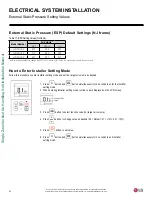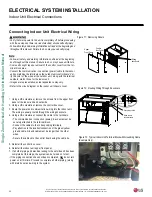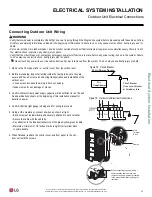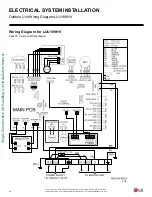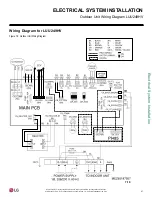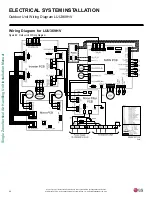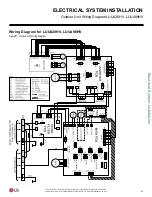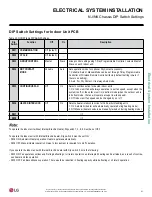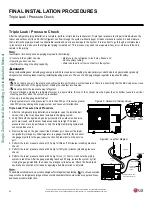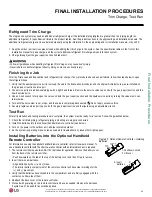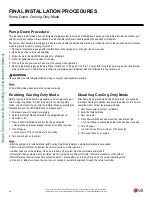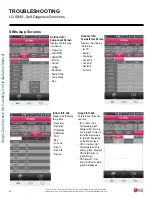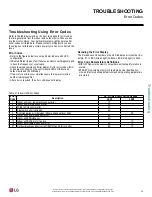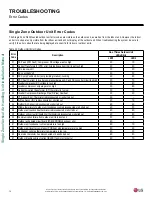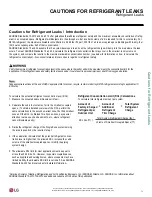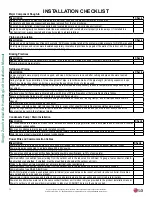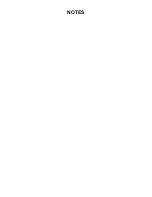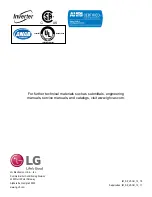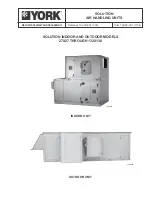
62
Single Zone V
ertical
Air Handling Unit Installation Manual
Due to our policy of continuous product innovation, some specifications may change without notification.
©LG Electronics U.S.A., Inc., Englewood Cliffs, NJ. All rights reserved. “LG” is a registered trademark of LG Corp.
FINAL INSTALLATION PROCEDURES
Triple Leak / Pressure Check
Triple Leak / Pressure Check
After the refrigerant piping installation is complete, perform a triple leak / pressure test. Triple leak / pressure test is performed between the
indoor and outdoor unit to verify that refrigerant can flow through the system without danger of leaks or pressure losses. Air and moisture
that is left in the piping can lead to undesirable results and can cause damage to the system. It is important to go through a complete leak
/ pressure cycle to make sure the refrigerant piping is cleared out. This process may need to be repeated if any air or moisture is found to
remain in the piping.
Insufficient or incorrectly done air purging may lead to the following:
DANGER
Using combustible gases, including oxygen may result in fire or explosion, resulting in personal injury or death. Use inert gas (medical-grade dry
nitrogen) when checking leaks, cleaning, installing/repairing pipes, etc. The use of a 600 psig nitrogen regulator is required for safety.
• Pressure in the system can rise.
• Operating current can rise.
• Insufficient cooling or heating capability.
• Moisture in the refrigerant circuit may freeze and
block capillary tubing.
• Water can lead to corrosion of parts in the system.
•
Do not apply power to the single zone system before performing a system leak test. There is a possibility that the EEV valve may close
and isolate sections of the piping system, making the leak test inconclusive.
•
Never perform the leak test using refrigerant.
• To avoid nitrogen entering the refrigerant system in a liquid state, the top of the cylinder must be higher than its bottom (used in a vertical
standing position) when the system is pressurized.
• Use only a leak-free gauge manifold set.
• Piping system must not be pressured to more than 550 psi. Pressures greater
than 550 psi may damage the piping system and cause unit malfunction.
Triple Leak / Pressure Check Procedure
1. After the refrigerant piping installation is complete, open the isolation ball
valves, if any, that may have been included in the piping system.
2. Verify that both the liquid and gas (vapor) suction line outdoor unit service
ports are closed, and the stem head access caps are tight. The leak /
pressure check is to be performed to only the refrigerant piping system and
connected indoor unit.
3. Remove the cap on the gas (vapor) line Schrader port. Connect the (medi-
cal-grade dry) nitrogen cylinder regulator to a gauge manifold, then connect
the gauge manifold to the gas (vapor) suction Schrader port on the service
port.
4. Perform the leak / pressure check at 150 psig for fifteen (15) minutes (standing pressure
check).
5. Perform the leak / pressure check at 300 psig for thirty (30) minutes (standing pressure
check).
6. Perform the leak / pressure check at 550 psig for one (1) hour to make sure the piping
system is leak-free. After the gauge reading reaches 550 psig, isolate the system by first
closing the gauge manifold, then close the nitrogen cylinder valve. Check the flared (and
any brazed connections) for leaks by applying a bubble solution to all joints.
The bubble solution must be a solution designed for refrigerant leak testing.
Do not use common
soap solution on refrigerant piping as those contain chemicals that could corrode copper and brass,
and cause product malfunction.
Figure 83: Leak Test Diagram.
Lo
Hi
Outdoor Unit
Gauge Manifold
Charge Hose
Nitrogen Gas
Tank (Upright
Position)
Indoor Unit
Refrigerant
Piping
Connected to Shrader Valve
on Gas (Vapor) Service Port
Figure 82: Outdoor Unit Service Valves.
Liquid Vapor
Содержание LV181HV4
Страница 73: ...NOTES ...



